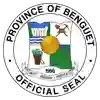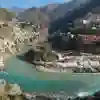Pamana: A legacy for the future
Philippine Mining from Legacy Impacts to Sustainable Future

Project summary
The Challenge
In the Philippines, a century of intensive mining has left contaminated land and water, impacting the health and well-being of local communities.
The Approach
Uniting UK and Philippine researchers in hydrogeochemical & ecological studies, sediment impact assessments and sustainable mining policy development.
The Outcome
Understanding impacts on Philippine River systems to empower stakeholders for sustainable mining practices and responsible resource management.
Institutes and centres

Pamana is Filipino for legacy
By equipping stakeholders with insights and tools to mitigate mining impacts, we aim to leave behind a “pamana” of a sustainable mineral resource for the Filipino people.
The Challenge
For over a century, the Philippines has grappled with the aftermath of intensive mining activities, leaving a legacy of environmental contamination and community health concerns. As global demand for critical minerals continues to rise, addressing the environmental and social repercussions of mining becomes increasingly urgent. Project PAMANA takes on the challenge of developing sustainable mining practices while considering historical legacies, current environmental impacts, and future mineral resource needs. This initiative underscores the need for innovative solutions that harmonise mining with environmental preservation.
The Philippines is the 5th most mineral rich country in the world. In 2019, there were 27 identified legacy mines across the Philippines.
The full research team
Professor Thomas Coulthard
Professor of Physical Geography
Dr Decibel V. Faustino-Eslava
Geologist at University of the Philippines - Los Baños
Dr Saraswati Thapa
Postdoctoral Research Associate
Dr Grigorios Vasilopoulos
Lecturer in Geospatial and Earth Observation
Prof Richard Williams
Fluvial geomorphologist and Geospatial Scientist
The Approach
PAMANA is a collaborative effort bringing together experts from the UK and the Philippines, supported by key Project Partners. The project extends its network, involving experts from diverse fields to carry out a comprehensive program. This includes baseline studies in hydro geochemistry and ecology, assessing the impacts of contaminated sediments, advanced mining impact modelling, managing tailings dams, and shaping sustainable mining policies. Through interdisciplinary collaboration, PAMANA adopts a multifaceted approach that harnesses collective expertise to tackle complex environmental challenges.
There is a 100-year history of intensive mining in the Philippines, that has left a legacy of contaminated land and water, sometimes leading to negative outcomes on the health and wellbeing of local communities.Professor Tom Coulthard
Professor of Physical Geography, Energy and Environment Institute
Under Professor Tom Coulthard, the University of Hull is leading on work package 3 in the Pamana Project:
Predicting past, present and future impact of mining in the Philippines
Contaminants from legacy and active mines travel through water catchment systems through sediments suspended in water.
The fate of sediment associated contaminants is dependent on sediment transport and thus the fluvial geomorphology of a catchment. The team will produce new two and three-dimensional numerical models of flooding and sediment transport to provide a clearer picture of how contaminants move and are stored within the environment.

Watch this short introduction to the Pamana project
5 mins
The Impact
PAMANA aims to provide a comprehensive understanding of mining's effects on Philippine River systems. Its overarching goal is to equip government agencies, mining companies, scientists, and local communities with the insights and tools needed to mitigate environmental and ecological impacts. PAMANA envisions a future where mining coexists harmoniously with nature and benefits local communities, preserving the invaluable Philippine ecosystems for future generations.
The knowledge and strategies developed by PAMANA extend beyond borders, holding potential for global adoption in addressing mining legacies and promoting responsible mineral resource management. Ultimately, PAMANA's impact reaches far and wide, advancing a global movement toward sustainable mining practices and responsible environmental stewardship.
Research Impacts
Academic Paper: Sustainable mining in tropical, biodiverse landscapes: environmental challenges and opportunities in the archipelagic Philippines
Highlights from the paper:
- The Philippines is mineral-rich and a global biodiversity hotspot
- Five environmental research challenges and opportunities are identified
- Contaminant management needs geochemical observations and geomorphological models
- National-scale water quality monitoring needs bioavailability-based devices
- Native plants & organic solvents have potential for ore and tailings metal extraction.
Academic Paper: Forever but not everywhere? Unexpected non-detection of per- and polyfluoroalkyl substances (PFAS) in major Philippines rivers
Highlights from the paper:
- PFAS occurrence investigated in major Philippines river systems characterised by both high and low population densities.
- In the Pasig Laguna de Bay River, which drains a major urban conurbation, we detected PFAS at concentrations typical of global rivers.
- Unexpectedly, we did not detect PFAS in river water or sediments in low population density river catchments.
- We hypothesise that septic tanks (dominant Philippine wastewater treatment practice) may control the release of PFAS into groundwater and rivers.















